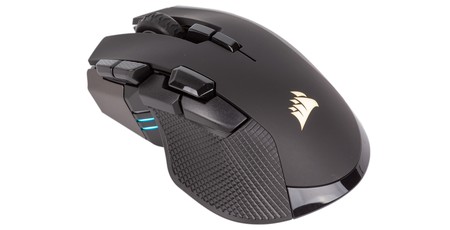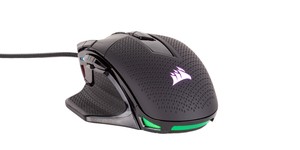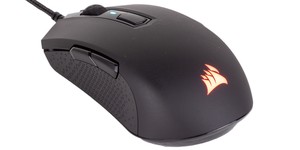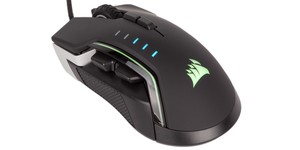
Manufacturer: Corsair
UK price (as reviewed): MSRP £69.99 (inc. VAT)
US price (as reviewed): MSRP $79.99 (exc. tax)
It took Corsair a long time to develop a decent palm-grip mouse, but the original Ironclaw RGB was a success in my eyes. Now, Corsair has added three new buttons and taken it wireless, and it’s charging £15 extra for the work. Doesn’t seem so bad, but let’s have a closer look.

Adding a battery to an already bulky design means only one thing: a heavy mouse. It tips my scales at 133g. This is almost double the weight of the Glorious PC Gaming Race Model O, and if you’re drawn to lighter mice this won’t be for you. It’s big too, measuring 130mm long and 80mm wide.

Corsair uses the volume to create a proper hand-filling shape that’s great if you use a palm grip. The ergonomics are spot on for this, and the combination of two textured rubber sides and a smooth matt top surface nicely balances comfort and grip. The front aluminium bracket and the large PTFE feet complete the picture of solid build quality, and the latter keep all movements very smooth.

You’ve three options for connecting mouse to PC. The primary one is 2.4GHz wireless, which relies on a simple USB dongle. Corsair’s Slipstream technology promises a 1ms response time i.e. the same as you’d get from a wired mouse with 1,000Hz USB polling. Pairing is achieved immediately, and at no point did input lag creep into testing with this mode. It’s as good as using a cabled mouse in my eyes (plus no cable drag!), but Corsair isn’t alone in offering wireless technology this good; it’s quite commonplace now. Battery life in this mode is claimed to be up to 16 hours with ‘standard’ lighting and up to 24 hours with no lighting at all.

You can also use Bluetooth 4.2, and you’ll find a dedicated three-way switch on the underside to toggle the wireless mode (or turn it off). This lets you switch easily between a gaming PC and work notebook, for example. Bluetooth offers a minimum response time of 7.5ms, which is unsuitable for fast-paced gaming, and you’ll feel the difference immediately, but for work and less time-dependent gaming it’s fine. The upside is it uses less power, with battery life rated here at up to 30 hours with standard lighting or up to 50 hours with none.
Lastly, you can resort to good ol’ wired mode via the supplied 1.8m micro-USB cable, which you’ll need to do to charge the thing. Time to charge from zero to full is a claimed two hours.

A small micro-USB to female Type-A USB adaptor is also supplied. If you intend on leaving the charging cable plugged into your PC, this is useful for giving you an easy-access USB port whenever it’s not connected to the mouse.

Though the core shape is unchanged, Corsair has added three extra buttons to the Ironclaw’s design for its wireless outing. Two to the side of left-click are assigned to DPI control, leaving the two behind the scroll wheel managing profile selection. The third extra button is that large one centred above the two thumb ones. Naturally, all 10 buttons are fully customisable through Corsair’s iCUE software.
Once again you get Omron switches rated to 50 million clicks for the main buttons. These have a 60gf operation force and 0.45mm actuation distance, and in use they feel crisp and consistent. I personally still find the scroll wheel of this mouse to be too stiff to click and too loose when scrolling, though, but I’m nitpicking there, as it’s perfectly usable.

The front DPI toggle is quick and easy to reach with the tip of your index finger, but the one behind takes more getting used to and would be better suited to less time-sensitive commands in games. Both these buttons are well sized and have a crisp, light action. The two main thumb buttons continue to be a joy to use, as their shape and action means they’re easy to hit at a moment’s notice. The new button above these has a downward action (not sideways or up), so you’ll need to roll your index finger onto it or get your thumb above it, neither of which feels natural. There are better ways to design a three-button thumb zone, I feel, but it’s still another customisable button within your arsenal.

Customisable RGB lighting illuminates the rear logo, the inside of the scroll wheel, and the front “headlights”. The zones are independently tweakable in the software.
There’s also a multi-purpose LED indicator zone with three LEDs that use varying patterns and colours to inform the user about battery status, connection status, the selected profile, and the current DPI level. In normal use it indicates which of three DPI stages you have selected. I found my thumb blocking my view of this area however and think it could do with being further forward to make it easier to see at a glance.
The Ironclaw RGB Wireless uses the same sensor as before, a custom PixArt PMW3391 with an 18,000 DPI resolution that you can customise in 1 DPI steps. Such a resolution is ludicrous, but it ticks a big number box, and there’s no real downside to it being so high assuming it tracks well at more realistic resolutions. Thankfully, this is absolutely the case, and I was unable to pick any real flaws in the sensor’s performance during use. There’s no perceptible jitter until you make things so sensitive that surface imperfections are picked up, and acceleration/deceleration is also absent.
The Ironclaw RGB Wireless supports three onboard profiles and many more software ones. To customise any of them you’ll need to use the iCUE software, which we get into over the page.

MSI MPG Velox 100R Chassis Review
October 14 2021 | 15:04








Want to comment? Please log in.